
The Lewis and Clark Expedition, also known as the Corps of Discovery Expedition, was the United States expedition to cross the newly acquired western portion of the country after the Louisiana Purchase. The Corps of Discovery was a select group of U.S. Army and civilian volunteers under the command of Captain Meriwether Lewis and his close friend Second Lieutenant William Clark. Clark and 30 members set out from Camp Dubois, Illinois, on May 14, 1804, met Lewis and ten other members of the group in St. Charles, Missouri, then went up the Missouri River. The expedition crossed the Continental Divide of the Americas near the Lemhi Pass, eventually coming to the Columbia River, and the Pacific Ocean in 1805. The return voyage began on March 23, 1806, at Fort Clatsop, Oregon, and ended on September 23 of the same year.

Meriwether Lewis was an American explorer, soldier, politician, and public administrator, best known for his role as the leader of the Lewis and Clark Expedition, also known as the Corps of Discovery, with William Clark. Their mission was to explore the territory of the Louisiana Purchase, establish trade with, and sovereignty over the natives near the Missouri River, and claim the Pacific Northwest and Oregon Country for the United States before European nations. They also collected scientific data, and information on indigenous nations. President Thomas Jefferson appointed him Governor of Upper Louisiana in 1806. He died of gunshot wounds in what was either a murder or suicide, in 1809.
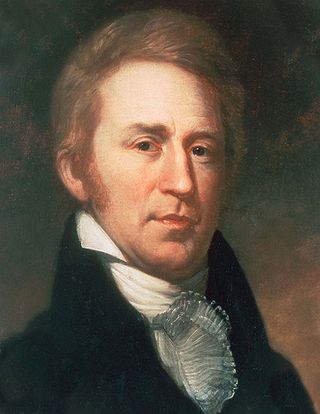
William Clark was an American explorer, soldier, Indian agent, and territorial governor. A native of Virginia, he grew up in pre-statehood Kentucky before later settling in what became the state of Missouri.
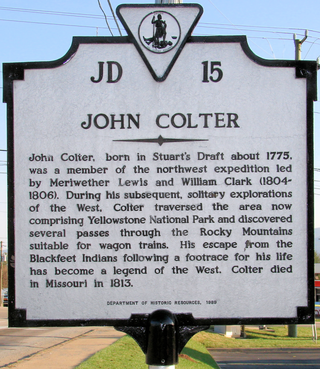
John Colter was a member of the Lewis and Clark Expedition (1804–1806). Though party to one of the more famous expeditions in history, Colter is best remembered for explorations he made during the winter of 1807–1808, when he became the first known person of European descent to enter the region which later became Yellowstone National Park and to see the Teton Mountain Range. Colter spent months alone in the wilderness and is widely considered to be the first known mountain man.
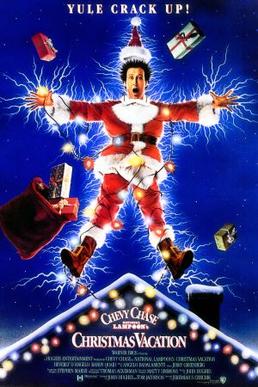
National Lampoon's Christmas Vacation is a 1989 American Christmas comedy film and the third installment in National Lampoon magazine's Vacation film series. Christmas Vacation was directed by Jeremiah S. Chechik, written and co-produced by John Hughes, and starring Chevy Chase, Beverly D'Angelo, and Randy Quaid with supporting roles by Miriam Flynn, William Hickey, Mae Questel, Diane Ladd, John Randolph, E.G. Marshall, Doris Roberts, Juliette Lewis, and Johnny Galecki, and special appearances by Julia Louis-Dreyfus, Nicholas Guest, Ellen Hamilton Latzen, Brian Doyle-Murray, and Natalia Nogulich.

The Floyd River is a tributary of the Missouri River, 112 miles (180 km) long, in northwestern Iowa in the United States. It enters the Missouri at Sioux City, and is named for Charles Floyd, a member of the Lewis and Clark Expedition.
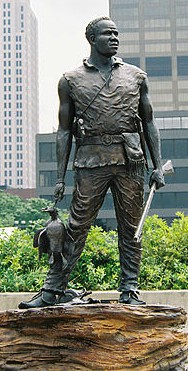
York was an American explorer and historic figure, being the only African-American member of the Lewis and Clark Expedition; he participated in the entire exploration and made significant contributions to its success. He was the first African American to cross the continent and see the Pacific. He has become an American icon and several monuments depicting him have been erected honoring his legacy.
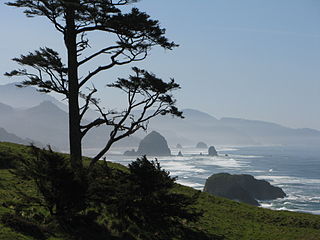
Ecola State Park is a state park located approximately 3 miles north of Cannon Beach in Clatsop County in the U.S. state of Oregon on the Oregon Coast. It is administered by the Oregon Parks and Recreation Department.

A buffalo jump, or sometimes bison jump, is a cliff formation which Indigenous peoples of North America historically used to hunt and kill plains bison in mass quantities. The broader term game jump refers to a man-made jump or cliff used for hunting other game, such as reindeer.

Beaverhead Rock, also known as Point of Rocks, is a rock formation overlooking the Beaverhead River in Montana protected as Beaverhead Rock State Park. It is located on Montana State Highway 41, twelve miles (19 km) south of Twin Bridges, Madison County. It was added to the National Register of Historic Places in 1970. The site may be viewed and photographed from a distance, but is not directly accessible.
Rex Ziak is a writer, historian, tour guide, and documentarian, who lives in Naselle, Washington, United States. Known for his Lewis and Clark studies, he is the author of In Full View. After careful study of the expedition's journals and of the geography of the Columbia River estuary, Ziak discovered the previously unknown fact that from November 7, 1805 to December 6, the Lewis and Clark expedition stayed in what is now Pacific County, along the Long Beach Peninsula. This finding took six years for Ziak to piece together, using the comments in the expedition's journals to find the locations the explorers stopped at on their trip. A controversy arose between Oregon, long considered the end of the expedition, and Washington's historians over Ziak's findings, with many historians in Washington and elsewhere supporting his discovery and many in Oregon opposing it. In 1999, soon after his announcement, Ziak and David Nicandri, director of the Washington State Historical Society, began petitioning to give the newly found ending location, a camping spot called Station Camp, National Landmark Status. In addition, that year, US Representative Brian Baird had an amendment passed that changed the "federal designation of the Lewis and CLark National Historic Trail as ending not in Oregon but in Oregon and Washington."

Lewis and Clark Caverns State Park is a 3,000-acre (1,200 ha) public recreation and nature preservation area located twelve miles (19 km) east of Whitehall in Jefferson County, Montana. The state park includes two visitor centers, ten miles of hiking trails, a campground, and its namesake limestone caverns. The Lewis and Clark Caverns Historic District was placed on the National Register of Historic Places in 2018.

Missouri Headwaters State Park is a public recreation area occupying 535 acres (217 ha) at the site of the official start of the Missouri River. The park offers camping, hiking trails, hunting, and water-related activities. It is located on Trident Road northeast of Three Forks, Montana at an elevation of 4,045 feet (1,233 m). The park includes the Three Forks of the Missouri National Historic Landmark, designated in 1960 because the site is one where the Lewis and Clark Expedition camped in 1805.

Lewis and Clark State Recreation Site is a state park in eastern Multnomah County, Oregon, near Troutdale and Corbett, and is administered by the Oregon Parks and Recreation Department. It is located on the Sandy River, near its confluence with the Columbia River. Broughton's Bluff marks the westernmost extent of the Columbia River Gorge at the site.

Camp Disappointment is the northernmost campsite of the Lewis and Clark Expedition, on its return trip from the Pacific Northwest. The site is on private land within the Blackfeet Indian Reservation in Glacier County, Montana. It is located along the south bank of Cut Bank Creek and 12 miles (19 km) northeast of Browning, Montana. Glacier National Park can be seen in the distance.

Sacagawea was a Lemhi Shoshone woman who, in her teens, helped the Lewis and Clark Expedition in achieving their chartered mission objectives by exploring the Louisiana Territory. Sacagawea traveled with the expedition thousands of miles from North Dakota to the Pacific Ocean, helping to establish cultural contacts with Native American people and contributing to the expedition's knowledge of natural history in different regions.

Lewis and Clark State Park is a public recreation area occupying 189 acres (76 ha) on the south shore of 365-acre (148 ha) Lewis and Clark Lake in Buchanan County, Missouri. The state park features camping, picnicking, and fishing.

The Far Horizons is a 1955 American Western film directed by Rudolph Maté, starring Fred MacMurray, Charlton Heston, Donna Reed and Barbara Hale. It is about the early 19th century Lewis and Clark Expedition, which was sent by President Thomas Jefferson to survey the territory that the United States has just acquired in the Louisiana Purchase from France. They are able to overcome the dangers they encounter along the way with the help of a Shoshone woman named Sacagawea. This is currently the only major American motion picture on the Lewis and Clark Expedition. Many details are fictional, and the minor scene where the group reaches the Pacific Ocean reflects the low budget of the film. The film was re-released in 1962 by Citation Films Inc. as Untamed West in a double feature with Jungle Attack.
Lewis & Clark: The Journey of the Corps of Discovery is a 1997 television documentary miniseries about the Lewis and Clark Expedition directed and co-produced by Ken Burns. It is produced by Burns' Florentine Films for Washington, DC PBS station WETA-TV, first aired on PBS on November 4 and 5, 1997.

Northwest Oregon is a geographic and cultural region of the U.S. state of Oregon, composed of Clatsop, Columbia, and Tillamook counties. The region encompasses the northernmost parts of the state along the lower Columbia River.
















